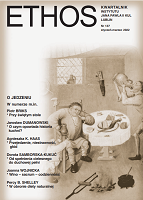JEDZENIE I CUD SZTUKI „THE IDENTICAL LUNCH” ALISON KNOWLES
FOOD AND THE MIRACLE OF ART: ALISON KNOWLES’ IDENTICAL LUNCH
Author(s): Dorota KoczanowiczSubject(s): Theatre, Dance, Performing Arts, Visual Arts, Philosophy of Mind, Sociology of Art
Published by: Katolicki Uniwersytet Lubelski Jana Pawła II - Instytut Jana Pawła II, Wydział Filozofii
Keywords: Alison Knowles; The Identical Lunch; Ludwig Wittgenstein; art; every-day life;
Summary/Abstract: Ludwig Wittgenstein is said to have stated that it did not matter to him much what he ate, as long as it always remained the same. Wittgenstein’s remark opens the author’s considerations of Alison Knowles’ performance The Identical Lunch. From 1967 to 1973, Knowles would eat the same kind of sandwich on a daily basis, did so at approximately the same hour, and in the same, today no longer existing, New York restaurant called Riss. However, those were no ordinary meals, but an artistic activity entitled The Identical Lunch. Over the time, Knowles was joined by other artists. Her friends would eat tuna sandwiches and record the circumstances of their meals: their impressions, the fl avors they experienced, the interesting companions they met, and the conversations they had, but also little things they would otherwise have never noticed before. The essence of the performance in question, as well as of other artistic actions of Fluxus, an artistic movement in which Knowles took part, was to blur the boundaries between art and life. The author of the article scrutinizes the problem of the conditions of the diffusion of culinary arts into the sphere of art and, while doing do, refers to the aesthetic theories that derive art from the experience of everyday life, such as those proposed, respectively, by John Dewey, Nicola Perullo, and Yuriko Saito.
Journal: Ethos. Kwartalnik Instytutu Jana Pawła II KUL
- Issue Year: 35/2022
- Issue No: 1
- Page Range: 214-228
- Page Count: 15
- Language: Polish
- Content File-PDF

